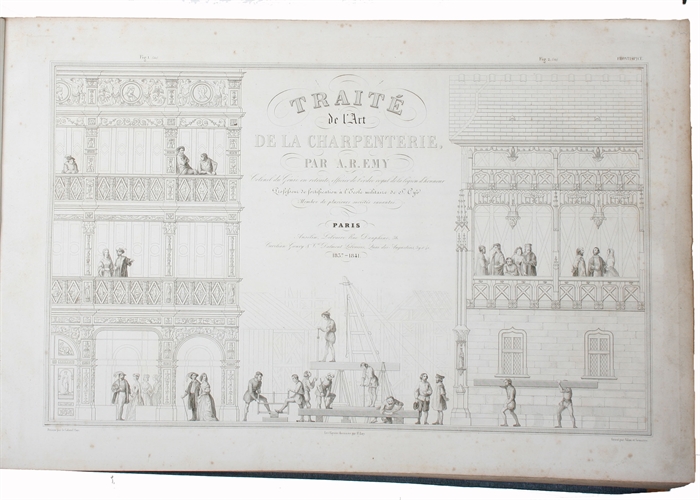SEMINAL WORK ON TIMBER CONSTRUCTIONS
ÉMY, A.R. (AMAND ROSE).
Traité de L'Art de la Charpenterie. [Text volume + plates].
Bruxelles, Meline, Cons et Comp., 1841-42 (Text vol.]; Paris, Anselin, Gaeury & V. Dalmont, 1841 (Plates).
Text volume: Royal8vo. Two volumes bound in one contemporary half calf. Library stamp pasted on to lower part of spine and library stamp to title page. Hinges with some wear but firmly attached. Internally very fine and clean. [Vol. 1]: (2), 575 pp; (4), 670 pp.
Plates: Folio-oblong both bound in contemporary half calf, with gilt lettering to spine. Spine with wear and hinges loose. First plates with a 5 cm long tear. Plates are fine and clean with occasional marginal brown spots. 157 engraved plates.
First edition of the first work on laminated timber engineering, being one of the most famous and influential books on the construction of timber roofing and large wood constructions in general. This is the first book since 1567 (De l'Orme. Le premiere tome dell'architecture) to deal with this subject in a scientific and analytical context.
Emy's work was organized as a manual describing concrete working phases and procedures and avoiding the usual philosophical and ethic speculations on the reasons to build. He gave precise instructions on minimize wood usage, waste reduction in the workmanship and realization processes of architectonic elements, manufacture assembling speed and work site cleaning.
"Armand Rose Emy's essay is one of the most interesting points of reference in the French and European cultural debate on timber construction [...]. Emy suggested a new wood coverage system inspired by the inventions of de l'Orme, architect and counsellor to the Court of King Henry II who wrote in 1561 Le nouvelles inventions pour bien bastir et a petit fraiz." (Mongelli. A New Wood Roofing System: Marac's Barracks and Colonel Armand Rose Emy's Innovative System)
"The greatness of Emy's work, the precision and the correctness of his studies and the validity of his invention led Emy to realise many barracks using this roofing system. Photographs show that the Marac barracks was in existence until the 1960s. Today, he must to be remembered for another reason. [...], it is Emy who should arguably be seen as the true father of this technique, as can be seen by his the first careful reflections and experimentation using this type of construction. In fact, studying the Wiebeking's bridge realized at Bemberga, Emy had even evaluated the possibility of introducing the blood-albumen glue between the thin plates to strengthen his semi-circular arch." (Ibid.).
Order-nr.: 44106


![Traité de L'Art de la Charpenterie. [Text volume + plates].](/images/product/44106b.jpg)
![Traité de L'Art de la Charpenterie. [Text volume + plates].](/images/product/44106c.jpg)
![Traité de L'Art de la Charpenterie. [Text volume + plates].](/images/product/44106d.jpg)
![Traité de L'Art de la Charpenterie. [Text volume + plates].](/images/product/44106e.jpg)
![Traité de L'Art de la Charpenterie. [Text volume + plates].](/images/product/44106f.jpg)
![Traité de L'Art de la Charpenterie. [Text volume + plates].](/images/product/44106g.jpg)
![Traité de L'Art de la Charpenterie. [Text volume + plates].](/images/product/44106h.jpg)
![Traité de L'Art de la Charpenterie. [Text volume + plates].](/images/product/44106i.jpg)